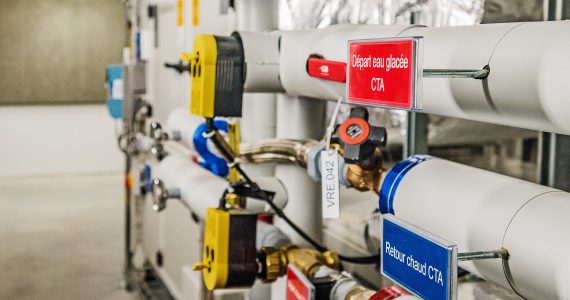
A short HVAC lexicon

Please follow the link HERE to explore the match-up between customer groups and thermal technicians.
To facilitate communication between thermal technicians and electricians, we need to use a common language.
Thermal engineering is a broad set of skills commonly called “HVAC” (which stands for “Heating, Ventilation and Air Conditioning”) in building construction.
HVAC experts are commonly subdivided into two categories:
- Heating technicians
- Chilled water experts
♦ What is the difference between a heating technician and a chilled water expert?
The heating technician installs boilers, primarily, or alternatively heat pumps to produce hot water. He may also install a connection to a district heating network via what is called a “heat exchanger”.
The heating technician distributes this hot water through pipes (flow and return in a “two-pipe” system) within the building to heat spaces via radiators, radiant floors, fan coil units and hot water air heaters.
The heating technician is also responsible for bringing in fresh air and extracting stale air, in most cases via CMV (controlled mechanical ventilation): one-way (exhaust-only) ventilation to extract air, typically from bathrooms, or two-way ventilation, which also includes fresh air supply from outside.
Air handling is done by means of encased ventilators or Air Handling Units, with air flowing through metal ducts, which are cumbersome and often cause space management issues in corridors.
Cooling is not part of the heating technician’s traditional skillset. However, with the advent of reversible heat pumps, he can now offer both heating and cooling with the same equipment.
In addition to his core skills, the heating technician has often acquired plumbing skills.
The chilled water expert masters not only heating systems, but also production and distribution of chilled water. Distribution is done via pipes (flow and return in a “two-pipe” system), which supply equipment that delivers air conditioning, air cooling or process heat compensation.
As a rule, complex aeraulic systems are handled by chilled water experts. Such systems require a combination of skills including heating, cooling, thermal balance calculations, air quality (through filtration), humidity control, comfort (air speed and temperature) and pressure cascade between rooms.
A combined two-pipe hot water system and two-pipe chilled water system is commonly called a four-pipe system.
The chilled water expert often has fewer plumbing skills than the heating technician.
There is also a distinction between the traditional HVAC technician described above and the “direct expansion” expert.
♦ What is a direct expansion expert?
The “direct expansion” expert, like the chilled water expert, has air conditioning and cooling skills.
However, direct expansion technology circulates a refrigerant (commonly called “freon”), rather than hot or chilled water, within the building.
Direct expansion systems operate with two pipes (or three pipes with energy recovery).
The fact that the term “two-pipe system” is also used by traditional HVAC technicians often causes confusion for people unfamiliar with the subject.
The direct expansion expert has skills similar to those of the refrigeration technician (focussed almost exclusively on chillers), but different from those of the chilled water expert. He may be more dependent on the manufacturers (such as Daikin or Mitsubishi) that supply the bulk of the system.
♦ Fundamentals
HVAC provides cooling, heating and fresh air supply in buildings.
Usually, heating and cooling are centrally produced within the building. Boilers can burn gas, fuel or wood pellets. Exhaust gases are removed via a stack.
Water chillers use phase changes in the refrigerant (commonly called freon) from gas to liquid and vice versa, and the related physical properties. Chillers also produce heat that needs to be removed (generally via external dry coolers on roofs). Connections to district cooling or heating networks can be an alternative to independent production.
Networks of pipes filled with hot or chilled water distribute heat and cooling to where they are needed. These hydraulic networks are usually insulated to prevent energy losses.
The heat or the cooling must then be distributed within the rooms, using terminals that can be either static or dynamic (with forced air).
Buildings are increasingly airtight. For the comfort of residents, fresh air therefore needs to be brought in from outside, and foul air extracted. Air handling is done mechanically by means of cased ventilators or, on a larger scale, AHUs (Air Handling Units) and a network of metal ducts.
The structural design of air and water networks and of centralised production systems is directly linked to the quality of the construction and to the use of the building. The design engineer must calculate the total heat gains (from the sun, human beings, computers, lighting, outside walls) and losses (mostly through heat exchanges with the outside).
For this reason, the HVAC technician must have skills in air handling, hydraulics and thermal balance calculations.
Did you like the article ?



